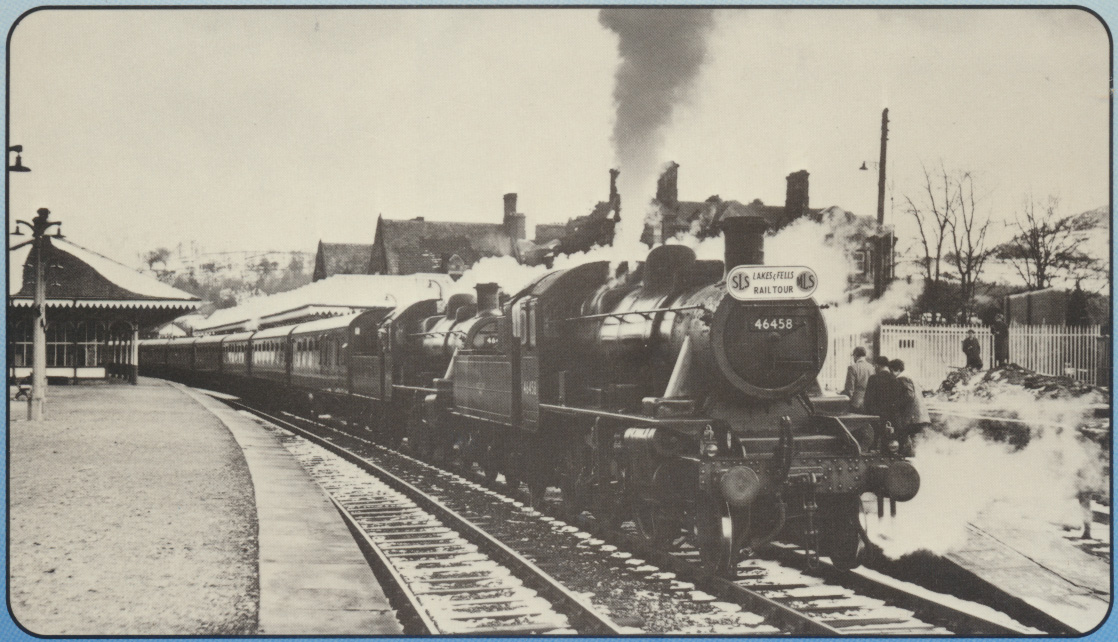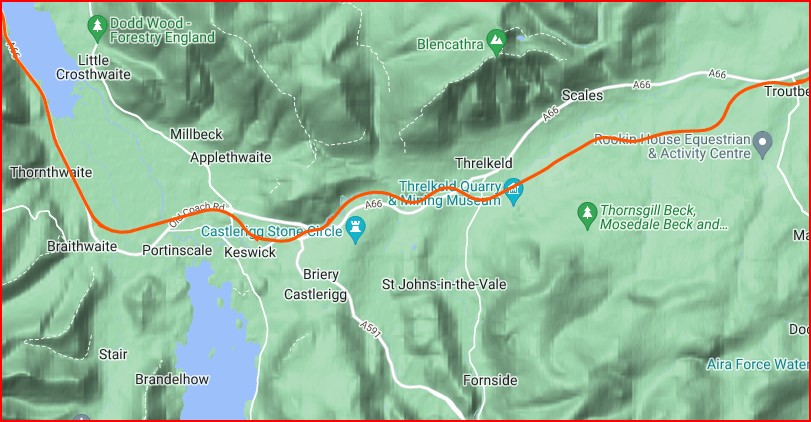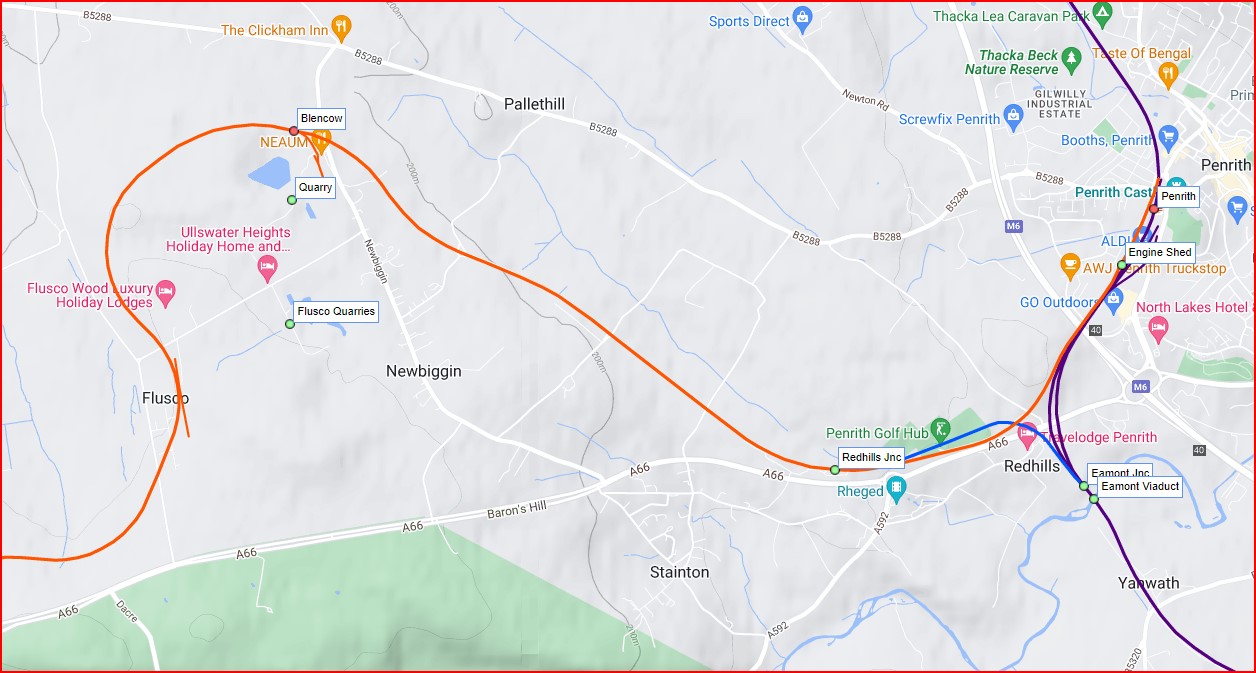Runaway Trains on the Penrith to Cockermouth railway
The CKPR [Cockermouth Keswick & Penrith Railway] distinguished itself by a number of spectacular runaways. Here are six incidents, two of them westward from Troutbeck.
It seems inconceivable today to have a whole train of goods wagons or carriages rolling away, uncontrolled, without brakes, but the only brake was on the locomotive at the front and at the brake van at the rear. It was many years before each wagon had its own brakes connected with vacuum pipes to actuate the brakes – so when there was a vacuum the brakes are sucked off the wheels, but when there is a disconnection then the vacuum is replaced by atmospheric pressure which forces the brakes on to the wheels. In those distant days, when a heavy load of wagons on a steep slope was detached from the loco, there were no brakes on the wagons and was an accident waiting to happen because if the brake van wasn’t adequate to stop the potential momentum then sometimes … read on.
Runaway train for 10 miles from Troutbeck through Keswick to Braithwaite
On Monday February 13 1871, an Up goods train reached Troutbeck, where the steam engine was detached, but about five minutes later its wagons started to run back down the long and steep incline to Threlkeld and away through the gorge, speeding by Keswick and over the lowlands, to come to rest beyond Braithwaite a distance of well over 10 miles and without harm.
Rails Through Lakeland, Harold D Bowtell, Silver Link Publishing Page 164
Runaway train Keswick Bassenthwaite Cockermouth
The CKPR’s second ‘runaway spectacular’ occurred on Tuesday April 18 1882, when an NER Down mineral train No.6 left Keswick travelling westward that morning, with two tender engines, 28 loaded coke wagons and two brake vans.
As the train ran along the shore Bassenthwaite Lake, the ‘ticket’ of authority for the section was duly carried. However, both guards were (irregularly) riding in the rear van – but this became detached and this van with the guards were thus left to coast to a standstill, while the train proceeded, with a single brake van at the rear but with no guard in it! The train continued past Bassenthwaite Lake station. Here, the leading driver collected the train staff for the next section.
He soon noted the absence of one brake van but proceeded to Embleton, whence the second engine took the train forward to Cockermouth. He held the staff for the section between Embleton and Bassenthwaite Lake so went back and joined the head guard, who came up on foot, and the Stationmaster.
The Stationmaster knew that another train was en route from Braithwaite, yet set off with the driver, fireman and guard to find and retrieve the missing van. After about a mile, on a curve by the lake, the van was seen approaching, propelled by the No.7 Down NER mineral train, which was duly carrying the train staff for the section.
The light engine driver reversed, the other three leaped clear of the footplate and the driver jumped (or was knocked off) when the propelled van struck his engine. BUT …This locomotive had been reversed and steam applied before impact and it now ran away at speeds estimated at 40-60mph, without its engine driver, passing Bassenthwaite Lake, Rakefoot and Embleton before running downhill to crash into the MCR’s 1.2Spm passenger train, which had been ready to leave Cockermouth for Brigham and Bullgill. It comprised an MCR tender engine and four vehicles.
The last two carriages were reduced to matchwood but, happily, a telegraphed warning from Porter Robinson at Bassenthwaite Lake to Clerk Patterson at Cockermouth had been received and acted upon with alacrity; this enabled the railway staff to get all the passengers clear just in time.
The MCR locomotive became detached but a porter dashed after it, climbed into the cab and brought it to a stand before it accelerated down the very steep bank to the Junction, thereby averting yet greater tragedy.
Rails Through Lakeland, Harold D Bowtell, Silver Link Publishing Page 164
First World War runaway train from Blencow to Penrith
Further runaways occurred during the years of the First World War. Trap points just east of Blencow on the bank down to Penrith, saved the situation on October 16 1916. A heavy down mineral train with two engines ran back when the drawbar of the leading (NER) wagon broke at Blencow. Had the trap points not been installed there would have been a fearful incident at the main line junction. In the earlier days of single track working east of Blencow there were no catch points and on December 26 1889 the 6.0am double headed Down goods from Penrith stopped at Blencow to shunt. While the engines were detached most of the train ran back all the way downgrade to Penrith station, happily with few ill effects.
Rails Through Lakeland, Harold D Bowtell, Silver Link Publishing Page 164
Runaway train at Troutbeck with munition (empty) shells
A far more spectacular runaway followed on Saturday October 28 1916, at about 8.0pm. The No. 30 Up goods was heavily loaded and hauled by two engines ascending the bank to Troutbeck, when the rear coupling parted on an LNWR wagon – the second vehicle in the train. The brake van at the rear could not hold the train, which ran away ‘wrong line’ down the bank. Guard Kirk, of Tebay, jumped for his life at Highgate Platform. The train, including 14 wagons loaded with steel shell cases from Workington, destined to be filled with explosives at the huge Ministry of Munitions factory at Gretna, derailed at the catch points in the cutting west of Highgate and an almighty pile-up resulted, partly on the lands of Highgate Farm. Mr Tyson, tbe farmer, ministered to the shocked guard with tea and his schoolgirl daughter Jessie clearly remembers the dramatic scene of the crash. It occurred close by the distinctive ‘la’al pikey hut’ – a superb Cumbrian description of the lineside cabin, which resembled a sentry box.
Rails Through Lakeland, Harold D Bowtell, Silver Link Publishing Page 164

Runaway train with gunpowder from Troutbeck to Threlkeld
Just over a year later, on December 13 1917, another runaway occurred. Fred Slee was conducting shunting movements at Troutbeck when, owing to a defective brake, Caledonian Railway gunpowder van No.20 (containing powder for use at Greenside lead mines) ran away down the bank, presumably ‘right line’ as it was not derailed by the Highgate catch points. The Highgate signalman warned Threlkeld, where the Stationmaster and his porter Signalman placed sleepers across the line just beyond (west of) the station; the van approached, running at about 30mph, and pushed the sleepers ahead of it for a distance before stopping short of the overline bridge carrying the Penrith Keswick road.
Rails Through Lakeland, Harold D Bowtell, Silver Link Publishing Page 164





